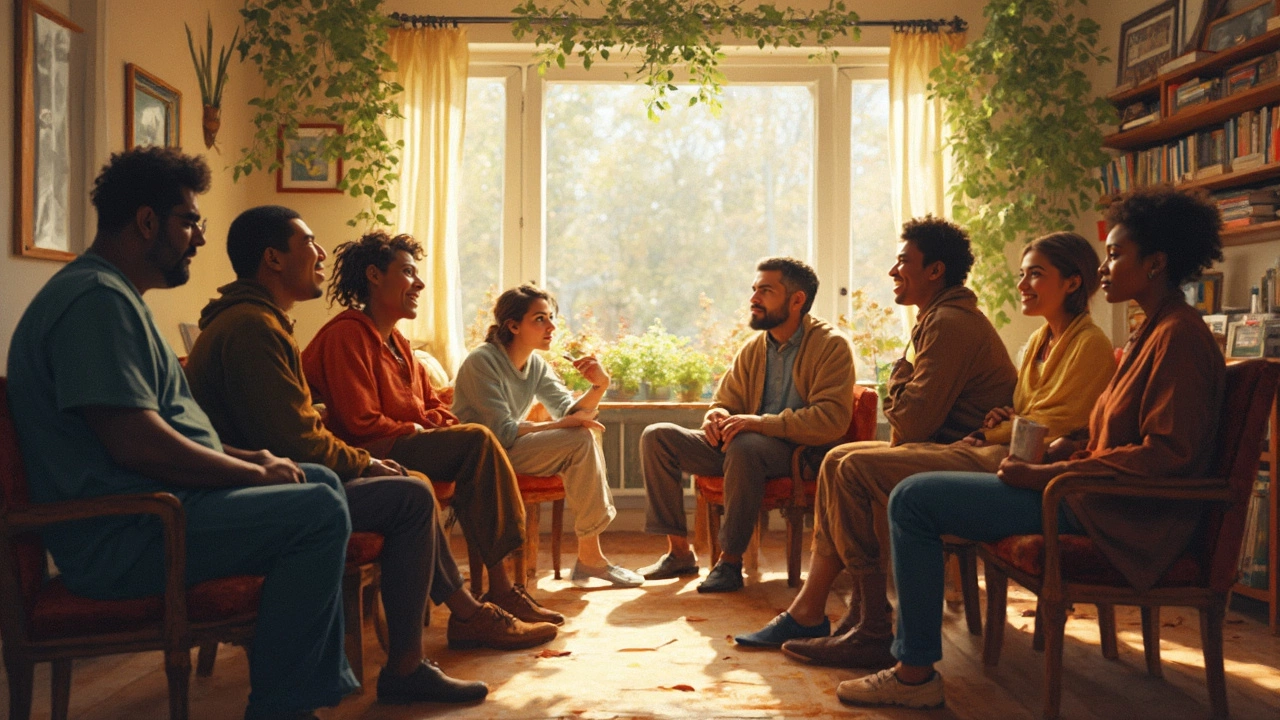Ever thought about why community outreach matters so much? It's like the glue that keeps our neighborhoods and cities thriving. You see, it's not just about turning up for an hour and calling it a day. Real community outreach digs deeper than that.
First off, understanding what community outreach truly means helps us appreciate its impact. It’s about creating genuine connections, understanding what your local area really needs, and figuring out how you can make a difference. It has a ripple effect—help one person, and the whole community begins to benefit. Cool, right?
Then there’s the human aspect of it. Real people, real impact. You might think it's all about serving meals or donating old clothes. And sure, those actions count. But often, it's about sharing skills, mentoring, or just spending time with folks who might need it. There's a whole world of opportunities to explore!
- Understanding Community Outreach
- The Importance of Local Connections
- Real-Life Examples and Success Stories
- How to Get Involved in Your Area
- Overcoming Challenges in Outreach
Understanding Community Outreach
Community outreach isn’t just a buzzword we toss around. It’s a core activity that brings significant positive impact to societies worldwide. So, what exactly is it? At its heart, community outreach involves reaching out and providing services, support, or aid to groups in need. But it’s more than simply offering help; it’s about building bonds and understanding community dynamics.
A handful of elements define effective outreach. First, there’s the understanding bit—getting to know who you’re helping, what their needs are, and the best ways to address those needs. It’s like being a good neighbor, but on a larger scale. Effective outreach is rooted in empathy and genuine engagement.
There’s a strong emphasis on volunteering and social action. From large organizations running nationwide campaigns to local groups tackling neighborhood-specific issues, there’s a spectrum of how these efforts look. Interestingly, a 2022 survey found that nearly 60% of UK residents volunteered at least once in the previous year, underlining how ingrained community service is in many cultures.
But here’s the real kicker: community outreach is mutually beneficial. The people reaching out often find as much reward as those on the receiving end. It builds social capital—those invisible yet essential connections that keep communities strong.
The ultimate goal? Empowering communities to become self-sustaining. Effective outreach initiatives aim to equip communities with tools and resources to solve issues independently over time, ensuring long-term positive change.
The Importance of Local Connections
Building local connections is the heartbeat of effective community outreach. It's not just about knowing your neighbors but about cultivating a network that can support and uplift everyone involved. Why? Because there's unparalleled power in collective action. When people work together, they're able to tackle issues more effectively. It’s like a chain reaction: one person's strength supports another's weakness, and together, they get things done.
Take, for instance, neighborhood watch programs. These rely heavily on the trust and cooperation of community members. They’re successful because they allow people to look out for each other, share crucial information, and keep everyone safe. Without those local bonds, such initiatives would fall flat.
Businesses, too, benefit from strong ties with their community. A local café supporting nearby events or featuring local artists can foster loyalty and mutual support. This kind of engagement isn't just good for business; it also strengthens the sense of belonging and collaboration in the area.
Schools often partner with local organizations for volunteer programs, offering students hands-on experience while helping meet community needs. It's a win-win because the students learn, and the organizations get much-needed assistance. In fact, a study showed that students participating in community outreach programs are more likely to stay engaged in their education as they see the real-world impacts of their efforts.
But how do you foster these connections? Start by getting involved in local events or join community groups online. Attend town hall meetings or simply spend more time engaging with neighbors. Don't underestimate the power of just showing up and being present.
In summary, nurturing local connections amplifies the impact of volunteering and social initiatives. Energies are aligned, resources are shared, and the collective gain is more significant than any single effort. That’s the real beauty of community.

Real-Life Examples and Success Stories
When you think about community outreach, it's easy to picture grand initiatives. But sometimes, the most impactful stories come from simple, everyday actions. Take, for example, the neighborhood lunch program in Leith, Edinburgh. This ongoing project started a few years back when a group of locals noticed some families were struggling to put food on the table. But it wasn't just about providing free meals. They created a space where people could connect, share stories, and support each other. It's incredible how something as basic as a shared meal can break down barriers and build a stronger community.
Another inspiring example is from Glasgow. A local group called 'Literacy for All' focused on improving adult literacy rates. They didn't just set up classes; they partnered with local businesses to create workshops. This way, they helped folks gain skills that directly improved their job prospects. What started as a small local effort expanded to a city-wide initiative, showing that teamwork can lead to incredible results.
If you're into stats, check out this quick snapshot of their impact:
| Year | Adults Reached | Businesses Involved |
|---|---|---|
| 2022 | 200 | 15 |
| 2023 | 450 | 30 |
| 2024 | 700 | 50 |
And how about the 'Green Fingers Project' in Aberdeen? This lovely initiative turned an old, unused lot into a community garden. People from all walks of life learned to grow their own veggies, reducing food bills and teaching valuable skills. Plus, it became a peaceful retreat for everyone involved. Now that's what I call a solid win for local impact!
All these examples show how volunteering and creativity open doors to endless possibilities. Engagement, empathy, and a splash of ambition can truly transform lives. Whether you're joining an existing project or starting your own, remember, you’re not just helping others; you’re helping build a true sense of community.
How to Get Involved in Your Area
Ready to dive into community outreach but not sure where to start? There are so many ways to get involved, fitting different interests and schedules, so you're bound to find something that suits you perfectly.
Start by checking out local community centers or nonprofit organizations. They often have volunteer programs that are desperate for extra hands. Plus, they'll help you understand what's needed most, whether it's tutoring kids or organizing a neighborhood clean-up.
Next, social media can be a surprising goldmine for finding volunteering opportunities. Platforms like Facebook and Instagram often have groups dedicated to local causes. Just a simple search and a couple of messages could land you a spot in an upcoming event.
Another cool option is signing up with online platforms like VolunteerMatch or Idealist. These sites list tons of opportunities based on your interest and location, making it super easy to find your match. Whether it's planting trees or helping at a local food bank, the options are endless.
- Join local groups or clubs focused on causes you care about
- Attend town hall meetings to identify community needs first-hand
- Ask friends and family how they get involved—sometimes word of mouth is the best guide
It's all about taking that first step. Once you're involved, you'll see how rewarding it is not just for the community, but for yourself too!

Overcoming Challenges in Outreach
Navigating the world of community outreach can sometimes feel like walking through a maze. You start with big dreams and lots of enthusiasm, but then, the reality hits you with challenges you never saw coming. But hey, don't worry—every obstacle comes with its own solution.
One biggie is lack of resources. You’d think just the people involved would be enough, but oh boy, does it help to have some cash and supplies! Try reaching out to local businesses or even launching a community fundraising event. You’d be surprised at how willing people are to chip in when they believe in a cause.
- Engage Locally: Partner with schools, churches, and local councils to gather more support.
- Leverage Social Media: Create a buzz online to attract both volunteers and resources.
Next up is communication—or rather, the lack of it. Miscommunication can derail even the best-laid plans. Keep everyone on the same page by using project management tools or simply setting up regular check-ins. It’s easier than you think to get tangled up in emails, so find a system that works for everyone.
Then there's burnout. Yup, it happens. Volunteers might lose steam if things get stale or too intense. To combat this, make sure to celebrate small wins and take breaks. Rotate tasks and keep things fresh by bringing in new ideas regularly. It’s all about teamwork!
Finally, sometimes the community might be slow to warm up. Trust takes time, and patience is key. Start by listening. Understand their needs and concerns before jumping in with solutions. It’s about building relationships—one smile at a time.
And just in case data sells better, here’s a quick look at common outreach hurdles and how often they're encountered based on a survey of outreach volunteers:
| Challenge | Frequency |
|---|---|
| Lack of Resources | 68% |
| Poor Communication | 55% |
| Volunteer Burnout | 48% |
| Slow Community Engagement | 42% |
See? You're not alone in this. By recognizing these challenges and tackling them head on, you're making your community outreach efforts not just a success, but a rewarding journey.
